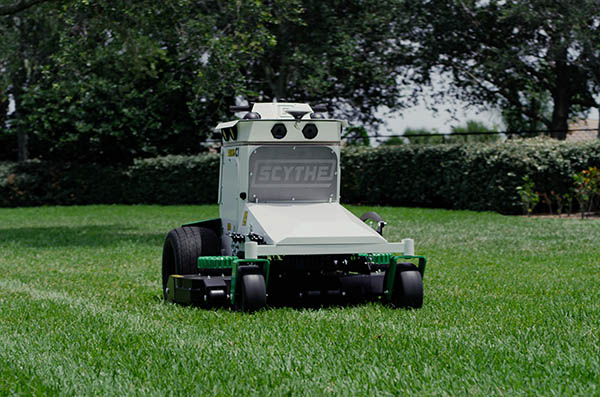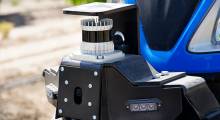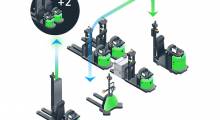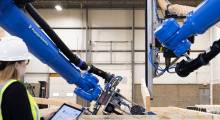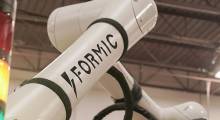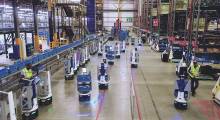The commercial landscaping industry is facing growth challenges including labor shortages and environmental concerns. Today, Scythe Robotics announced $13.8 million in Series A funding, bringing its total financing to $18.6 million. The Boulder, Colo.-based startup said it plans to use the new investment to grow its operations, add customers, and further develop autonomous systems.
The $105 billion U.S. landscaping industry has struggled with labor shortages and “hasn't seen substantial technological innovation in decades,” asserted Scythe Robotics. The company, which was founded in 2018, said its autonomous mower is designed to keep crew productivity high while also increasing the quality of cut and worker safety.
Scythe said its robotic mower includes eight high dynamic range (HDR) cameras and other sensors to operate safely in dynamic environments by identifying and responding to the presence of humans, animals, and other potential obstacles. The mower's electic design also reduces emissions and noise, according to the company.
In addition, the machine can capture property and mower performance data, helping contractors improve workflow, identify upsell opportunities, schedule more efficiently, and manage labor costs, said the company. Scythe offers its mower through a robotics-as-a-service (RaaS) model.
“I have been actively looking for solutions that will support our frontline employees and increase the efficiency of our operations, and Scythe’s product will do just that,” said Ivan Giraldo, co-founder and president of Austin, Texas-based Clean Scapes, one of the largest landscape companies in North America. “I’ve been open with employees about the opportunity autonomous mowers will bring—to get them off the mowers and onto higher-value landscaping work, enabling us to take on many new contracts.”
Inspired Capital led Scythe's Series A round, with participation from existing investors True Ventures, Zigg Capital, and Lemnos.
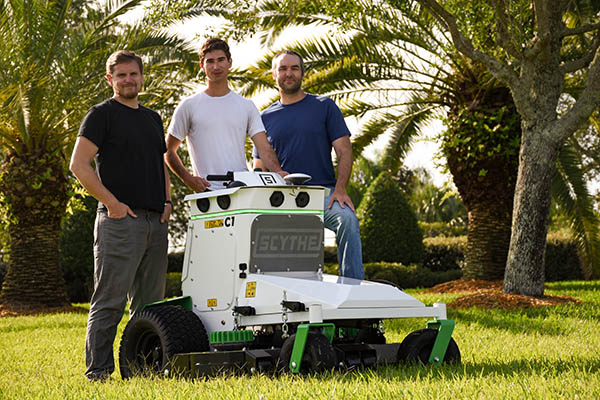
Jack Morrison, co-founder and CEO of Scythe Robotics, replied to the following questions from Robotics 24/7:
Scythe Robotics specs
How large will your autonomous lawnmower be?
Morrison: Scythe’s first autonomous machine is a commercial-grade, 1,100-lb., 52-in.-wide stand-on mower. The 52-in. cutting deck has three 18-in. blades and can quickly mow large open areas, such as parks or campuses, while still being agile enough to mow smaller spaces.
This is no “lawn Roomba,” unlike many of the existing so-called robo-mowers homeowners can buy today. We've built a machine that's tailored to the needs of professional landscape contractors who maintain millions of acres across the U.S. every day. This means it's built from thick tubular steel with shock-absorbing components isolating the electronics and careful consideration taken when placing sensors so they can last years in the rugged environments where our machines work.
Will it be able to closely groom golf courses? Is there a minimum or maximum area to be mowed?
Morrison: We’ve designed our machine to be what’s known as a rotary mower, the type of mower typically deployed in commercial landscaping applications, with quickly spinning blades parallel to the ground which create lift and cut the grass as it stands up.
Golf courses use reel mower technology, which is more targeted at that precision cut, as is seen on greens and fairways. We certainly see expanded mower types like dedicated golf mowers in our future at Scythe, but we’re squarely focused on the broader opportunity in the commercial landscaping industry today.
Our mowers will be capable of mowing upwards of 12 acres per charge to allow our customers the freedom to conquer substantial ground every day. Because we bill our customers based on the acreage covered by our machines, we're directly aligned with them when it comes to the goals of our machine: We want it to cover the most ground possible every day it's working.
What sort of mapping or presets will the lawnmower require?
Morrison: Scythe’s autonomy doesn’t require any pre-mapping of the full mowing areas. The one-time setup process is simple: The first time any Scythe machines visit a property, the operator simply rides around the perimeter of each mowable area, recording the boundary. On future visits to the property, the mower reloads those boundary maps and can be dispatched to mow with the push of a button.
Our Scythe Seeing vision system is capable of navigating through complex environments without full pre-mapping. It fuses a range of sensor inputs on the fly to derive not only an incredibly accurate, high-frequency position estimate but also the structure and semantics of the world around it.
We're able to record this map so that the next time our machine visits the property, we can automatically update property managers about things like how much the hedges have grown or offer advice if our machine has identified a grassy area that is suffering from lack of nutrients or water.
Although Scythe's lawnmower is described as fully autonomous, will there be a remote-control feature?
Morrison: Scythe’s mower actually has manual controls akin to any other commercial lawn mower on the market today. This allows landscape contractors to use the machine in many of the same non-mowing ways they do today, for instance, as a transport vehicle across large properties.
It will also let operators take care of the highly complex or small areas where autonomy doesn’t necessarily make sense to deploy today.
As a fully electric vehicle, what range and recharge time is Scythe aiming for? Will the robot use swappable batteries?
Morrison: We’re targeting a full eight hours of mowing on a single charge with an industry-leading 20kWh battery pack. We’ve tightly integrated the battery system with the overall machine for the optimal size and weight distribution and didn’t want to lose that to use swappable packs.
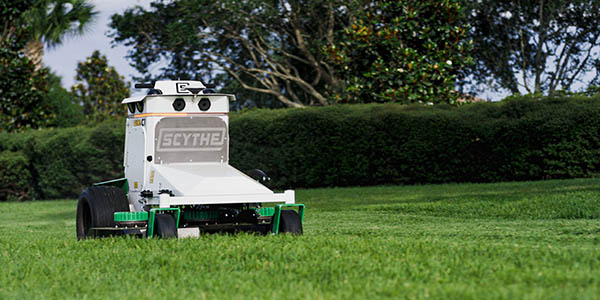
RaaS and training
Why did Scythe Robotics decide to go with a RaaS model?
Morrison: When we started Scythe, we did a deep dive into how the landscaping equipment industry worked today, and we were surprised to find many OEMs were misaligned with what their customers really needed.
A mower manufacturer who only makes money on new purchases or repair parts has little incentive to build a machine that lasts as long as customers would like. It sometimes appears that they are in a race to the bottom, building machines as cheaply as possible, and targeting only a few thousand hours of mowing before a machine has to be replaced.
We wanted to instead align with our customers so that when our customers grow, Scythe grows alongside them. We’ve seen this work superbly across the technology industry, from Stripe to AWS, and we believe that our Usage-Based Rental model at Scythe is similar.
By billing per acre mowed, our customers are able to more accurately predict their maintenance costs for properties and acquire machines at low or zero upfront cost, while Scythe has the benefit of a steady recurring revenue stream and the ability to upgrade machines in the field without being forced to support legacy machines. It’s a win-win for everyone.
How much training will facilities managers or operators need to set up the mower, or is that covered under RaaS?
Morrison: Operating our mowers is largely similar to driving a manual commercial mower with the addition of our “Scythe Mode,” where full autonomy is only a few clicks away. This is another reason building our machine from the ground up was so important to us. It gave us the opportunity to build a great user experience where autonomy was simple and intuitive.
Scythe will also offer video training content to bring new operators up to speed quickly on using our machines to save them time and training resources internally.
Facilities managers and property owners won’t have to change a thing about their properties, all they’ll see is that the landscape professionals they contract or employ to care for their grounds are suddenly able to get far more done and make a lot less noise doing it.
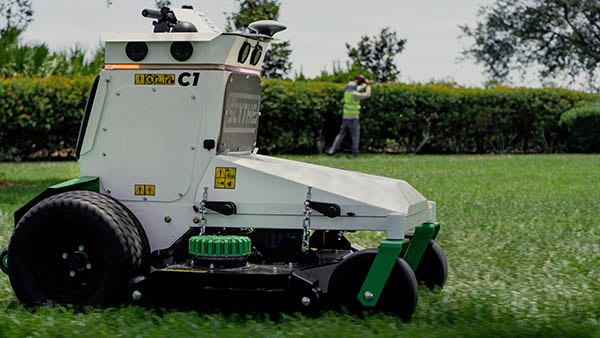
Growth plans
What is Scythe Robotics' current staff, and is it hiring?
Morrison: Scythe is a team of about 30 today, staffed with experts across disciplines, from mechanical and electrical engineers to cloud and machine learning software engineers. We're headquartered just outside Boulder, Colo., with offices also in Austin, Texas, and Vero Beach, Fla. We're hiring across our team in all three locations with remote work absolutely an option for great candidates.
We'd love to add more amazing Scythers to our team who are passionate about changing and growing humanity's ability to take care of the world around us. We have an opportunity to not only replace incredibly polluting and noisy power equipment with emissions-free, nearly silent machinery, but also to reduce the cost and improve worker productivity in how we maintain millions of acres of beautiful green spaces throughout this country and eventually around the world.
About the Author
Follow Robotics 24/7 on Linkedin
Article topics
Email Sign Up

